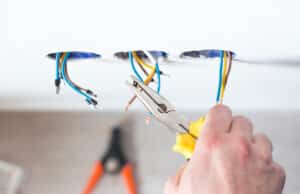10 Jun Ensuring Safety in Older Homes: Signs of Faulty Electrical Wiring
The warning signs you shouldn’t ignore!

Introduction: Old homes have a unique charm and character, but behind their vintage appeal lies the potential for electrical hazards. If you’ve recently purchased an older home, it’s crucial to prioritize the inspection of your electrical system by a licensed electrician. Faulty wiring can pose a serious risk, leading to electrical fires and jeopardizing the safety of your family. In this blog post, we outline the top signs of bad wiring in your house and provide guidance on how to respond, ensuring a secure living environment for you and your loved ones.
Recognizing the Signs of Faulty Wiring:
- Frequently Tripped Circuit Breakers: Tripped circuit breakers are a protective measure that prevents damage to your home’s electrical system. If you find yourself repeatedly resetting circuit breakers due to overloading or power surges, it could indicate faulty wiring in older homes. Contact a professional electrician to conduct a thorough inspection and address any potential issues.
- Flickering Lights: While flickering lights may seem like a minor annoyance, they can indicate underlying wiring problems. Loose bulbs or faulty outlets are common causes, but outdated or damaged wiring should not be overlooked. Consult a licensed electrician to diagnose and replace the problematic wiring safely.
- Crackling Noises: Although electricity can produce some sounds, loud crackling, buzzing, or popping noises are cause for concern. These noises could be indicative of faulty wiring or loose connections, which require immediate attention. Contact an electrician to assess your electrical system and identify the source of the problem.
- Frayed Wires: Over time, wires can become frayed, leading to potential safety hazards. Infestations by rodents or other pests can also contribute to wire damage. It is crucial to refrain from attempting DIY repairs on faulty wiring. Seek the assistance of a professional electrician to prevent emergencies such as electrocution or fires.
- Knob and Tube Wiring: Knob and tube wiring, commonly used in homes before the 1950s, is not suitable for powering modern-day technology. If your older home still relies on this outdated wiring method, it’s important to consult a professional electrician to discuss options for replacing and upgrading the wiring to ensure safety and compatibility with your electrical needs.
- Warm Spots on Walls: Walls should never feel hot to the touch. If you detect any warm spots along your walls, it may indicate a serious underlying issue within the electrical wiring. Don’t delay—schedule a comprehensive wiring inspection with a professional electrician to address and resolve the problem promptly.
- Burning Smells: The presence of a burning smell, especially when no cooking or other activities are taking place, is a clear indication of a severe wiring problem. Ignoring such odors can lead to catastrophic house fires. If you experience a burning smell, contact a licensed electrician immediately to investigate the issue and rectify any potential hazards.
With that said: When it comes to the electrical system in older homes, vigilance and proactive measures are vital for ensuring the safety of your household. By recognizing the signs of faulty wiring, such as frequently tripped circuit breakers, flickering lights, crackling noises, frayed wires, knob and tube wiring, warm spots on walls, and burning smells, you can take appropriate action to mitigate risks. Contact a professional electrician at Wahl Heating, Cooling & Plumbing today, to conduct a thorough inspection, diagnose any issues, and implement necessary repairs or upgrades. By addressing potential electrical hazards promptly, you can enjoy your older home’s charm while prioritizing the safety and well-being of your family.

